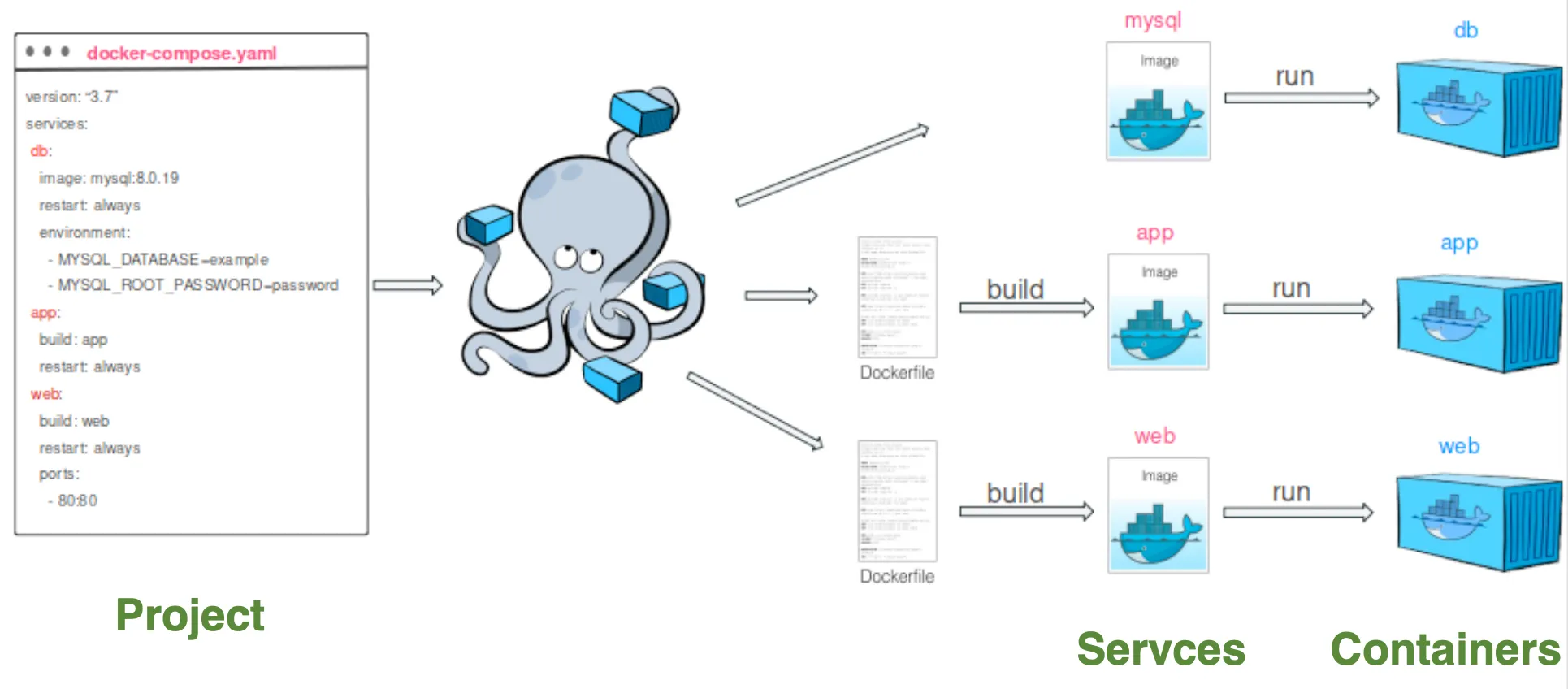If you've ever worked with Docker, you're probably familiar with "packaging" your application into individual containers. But what happens when your app isn't just a single container, but a complex system with multiple components interacting—like a web server, a database, and a cache server? Managing them manually with long docker run commands quickly becomes a nightmare.

This is where Docker Compose steps in—not as a musician, but as a talented conductor 🎼.
What is Docker Compose? A Simple Explanation
Docker Compose is a powerful tool for defining and running multi-container Docker applications. It lets you use a single YAML file (docker-compose.yml) to configure all your application's services, networks, and volumes. With just one command, you can launch and operate your entire complex system.

Simply put, instead of "commanding" each musician (container) individually, you just hand the score (docker-compose.yml) to the conductor (Docker Compose), and it orchestrates everything into a perfect symphony.
Why is Docker Compose a Developer's Lifesaver? 💡
The magic of Docker Compose isn't just that it works, but how it completely changes your workflow.
1. Absolute Simplification
Forget those mile-long docker run commands with all the --link, -p, -v,... parameters. Now, everything is wrapped up in a single, easy-to-read, easy-to-manage docker-compose.yml file.
-
Before (Manual):
# Run database container docker run -d --name my-db -e MYSQL_ROOT_PASSWORD=secret mysql:8.0 # Run web app container, link to database docker run -d --name my-app -p 8080:80 --link my-db:db my-webapp-image -
After (With Docker Compose):
docker compose up -dThat's it! Your whole system is up and running.
2. Consistent Environments, Efficient Development
Docker Compose ensures that everyone on your team—from developers to QA to DevOps—works in exactly the same environment.
The docker-compose.yml file can be shared via Git, eliminating the classic "It works on my machine!" headache. This saves tons of debugging time and ensures consistency from development to production.
3. Manage Application Lifecycle with One Command
You can start, stop, restart, view logs, and remove your entire application environment with simple commands:
docker compose up: Initialize and run the whole application.docker compose down: Stop and remove all related containers and networks.docker compose logs -f: Follow logs from all services in real time.docker compose ps: View the status of all containers.
4. Automatic Network Integration
When you run docker compose up, it automatically creates a private network for all services in the config file. Each container can communicate with others using their service names (e.g., the web service can connect to the db service via the hostname db). No need to worry about IP addresses or complex --link flags.
The docker-compose.yml File – The Heart of Docker Compose
docker-compose.yml is where you define everything. Let's break down a classic example: a WordPress app that needs a MySQL database.
version: '3.8'
services:
db:
image: mysql:8.0
container_name: wordpress_db
volumes:
- db_data:/var/lib/mysql
restart: always
environment:
MYSQL_ROOT_PASSWORD: your_strong_password
MYSQL_DATABASE: wordpress
MYSQL_USER: wordpress
MYSQL_PASSWORD: user_password
wordpress:
image: wordpress:latest
container_name: wordpress_app
ports:
- '8080:80'
restart: always
environment:
WORDPRESS_DB_HOST: db
WORDPRESS_DB_USER: wordpress
WORDPRESS_DB_PASSWORD: user_password
WORDPRESS_DB_NAME: wordpress
depends_on:
- db
volumes:
db_data:
Key components:
version: Declares the Compose file syntax version.services: The "soul" of the file, where you define the containers to run.db,wordpress: Your service names, which also act as hostnames in the internal network.image: Specifies the Docker image to use for the container.ports: Maps ports between the host and the container.volumes: Ensures data (like databases) isn't lost when containers are recreated.environment: Provides environment variables to the container.depends_on: Sets the startup order between services.
Docker Compose vs. Dockerfile: Don't Get Confused! 🤝
This is a crucial point that often confuses beginners.
- Dockerfile: A blueprint for building a single Docker image. It contains instructions like
FROM,COPY,RUNto create the environment for one app component (e.g., building an image for a Node.js app). - Docker Compose: An overall plan for running and orchestrating multiple containers (built from images) together.
Imagine you're building a house:
- Dockerfile is the detailed drawing for a brick (how to make it).
- Docker Compose is the architectural plan for the whole house, specifying where each brick goes and how they're connected.
Must-Know Docker Compose Commands 🚀
Here are the commands you'll use every day:
| Command | Function |
|---|---|
docker compose up | Build (if needed), create, and start all containers. Add -d for detached mode. |
docker compose down | Stop and remove containers, networks, and volumes (with --volumes flag). |
docker compose ps | List the status of all services in the app. |
docker compose logs [service_name] | View logs for one or all services. Add -f to follow in real time. |
docker compose exec [service] [command] | Execute a command inside a running container (e.g., docker compose exec db bash). |
docker compose build | Rebuild images for services with a build section. |
docker compose pull | Pull the latest images from the registry. |
docker compose restart | Restart all services. |
Conclusion: Docker Compose is an Essential Piece
Docker Compose isn't just an optional tool—it's an essential part of the modern Docker ecosystem. It turns managing complex, multi-component applications from a manual, error-prone task into an automated, consistent, and efficient process. By mastering Docker Compose, you're equipping yourself with a crucial skill to optimize your workflow, minimize mistakes, and speed up your product's time to market.
Start using it today, and you'll wonder how you ever lived without it!
![[Docker Basics] What is Docker? How has it changed the programming world?](/images/blog/what-is-docker.webp)
![[Docker Basics] Docker Volumes: How to Store and Manage Data](/images/blog/understanding-docker-volumes.webp)
![[Docker Basics] Image and Container: Concepts, Differences, and Usage](/images/blog/docker-image-and-container-thumbnail.webp)
![[Docker Basics] Essential Commands to Run Docker Containers](/images/blog/how-to-run-docker-container-thumbnail.webp)